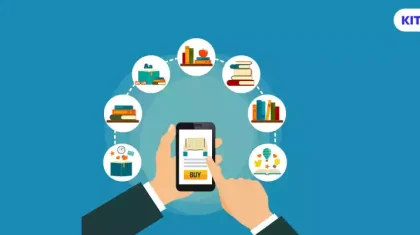
Looking Beyond the LMS for Digital Transformation in Education
Summarize this blog with your favorite AI:
If your idea of going digital with learning is just installing an LMS, you risk missing the bus. Read this to find out the silver bullet to making learning come alive without the related exorbitant costs through digital transformation in education.
There’s just so much to say on this topic that if I write about it in an article format, it will run into pages and become a full implementation report! 🙂 So, this is going to be a somewhat short-format version of it, to give you a precise level idea of some of the other things you need to think about beyond an LMS.
LMS - The First Step
Almost every education administrator and L&D manager know what a Learning Management System (LMS) is. Most have implemented one in their organization too. But while it seems like a reasonable way to launch online classes, disseminate some learning content digitally, track assessments, and generate reports, it is hardly the end state you need to be in! It is the first step. An LMS basically says that your learners now can have a link with the learning organization – administrators, teachers, and supervisors – via a portal. With this you now have the basic spadework done. But it leaves much to be desired in terms of the learning experience for students, and content security for administrators. The good thing is, if you have a half-decent LMS, it should integrate well with many learning apps. The real power to make a difference lies here.
[India-specific: If you are an education administrator in India, whether you are in the K-12 or the HigherEd spaces, NEP 2020 is right around the corner for you. Just handing over a bunch of PDFs via a portal won’t do anymore. You’ll need to make learning more situated in experience, appeal to multiple senses and different learner types, and teach students to think critically and apply their learning. An LMS has limited tools to support this need.]
#1 Learning is Now Hybrid - let's face it!
Whatever be your form of education, training, or skill-building offering, part of learning is likely to be online, part offline. Or at least, you will have a live session virtually. In essence, this means that giving the student a user id and password to your LMS and forgetting about it won’t cut it. You need to engage in discussions, and contextual Q&A when doubts arise, be able to schedule and conduct virtual live events, and store recorded lectures. These are now par for the course.
#2 The Power of App Integration
The real power of learning comes in targeted interventions. For example, providing additional lab practice might be beneficial to a student of high-school Chemistry. A graphing tool might help a student visualize Quadratic Equations. An art appreciation app might help the student of visual arts learn the nuances of his trade. A multiple choice question short-assessment question bank might be a boon just before exams.
If you are an L&D manager, you may want to think in terms of adding coding practice platforms, writing practice platforms, grammar tools, and even language translation ones. There are even industry-specific apps like color-matcher (fashion/product industry), oil rig configuration apps, etc. By plugging these into your LMS, you should be able to deliver more flow in the learning, so that learners can readily use these tools to resolve doubts, practice skills, and build competencies.
There are a bunch of learning apps in the market. You have to spend some time going through them and seeing what fits. If you need a programming plugin, research well whether it is at the right level for your learners, and whether it plays well with your current systems. Be it the mighty (yet humble!) Khan Academy for subject knowledge, or the mighty (yet easy-to-use) KITABOO for consuming ebooks, podcasts, and videos securely, you need to explore how to add value to your learners and teachers in very specific ways. When you pick a learning/assessment app, make sure it can integrate with your #LMS – good apps make sure that is possible by being “#LTI-compliant“. If you are in the USA, it had also better be easy to integrate with #Clever and #ClassLink!
#3 Making Content Come Alive - Really, do read this - you'll be glad you did!
The old adage in our industry that Content is King is relevant even now. From making content digital (converting textbooks to eBooks) to creating interactive simulations, there is a wide range of options as to how far you want to take the content sophistication journey.
One of the stories I like to share is how medical publishers worldwide are realizing the power of integrated content experiences for their medical books. What that means is that when a chapter is discussing fractures of the ankle, the traditional book can only carry one or two pictures of the related X-rays. In a physical book, it is impossible to zoom in, and you are reliant on the publisher’s printing quality to see anything. In an eBook, you can zoom, but when you go deeper and deeper, you lose the surrounding context. You can only see that part. That is not ideal. Also, you are stuck with only those 2 images as the textbook can carry.
But what if we could change that and make medical education truly immersive and effective? What if you (as a publisher) could add high-resolution images to the eBook beyond what the original printed book carries? What if your readers could launch those images and explore them while keeping the reading material in context? Imagine being able to read about a hairline fracture in the talus bone while seeing a bunch of different images right alongside it with the option to explore them in depth.
What if you could embed the entire animation of the direct and indirect pathways of the basal ganglia right alongside the relevant text in the chapter on motor control in the brain? What if they could be represented as flowcharts AND/OR as animation within the brain structure itself so that different students can learn from their preferred representations? What if you could embed one of those brilliant YouTube videos that prepare you for USMLE exams right alongside the same, but without cluttering the page? An interested student could go from awareness to understanding to application to critical thinking, all from just one page of the textbook – just because it was enriched with the right resources!
What if your English literature prose could be made readable in a hands-free mode so that a student commuting by bus or subway train can listen to the text or story and familiarize himself with the content ahead of class?
Making content come alive is powerful beyond what we might think at the outset. But it need not be expensive or hard work. Ask around to see just how simple it can be! Anyone should be able to do it – no tech skills, no programming, nothing. Just drag & drop stuff while you focus on making the curriculum delivery interesting for the learner.
#4 It Should Make Business Sense aka GROWTH ENABLER
Look, if your technology investments are just cost-centers, it is only a matter of time before you are asked to look at diminishing budgets to buy more or even maintain what you have. Ideally, your tech investments should help you grow your business faster than ever before. In this, there are two key things to look out for:
1) Does your investment integrate well with sales channels such as eCommerce sites?
2) Does the product help you onboard and sell your offerings to other individuals or businesses beyond just your current user groups?
The latter is a subtle, but extremely powerful point. If you have invested a certain amount of money in creating good content/curriculum, and you are monetizing it with a certain user group currently, why not use it for more than just your current users? Discover new partnership opportunities by licensing your content safely and securely through 3rd party agencies – universities, corporate agencies, associations, conference publishers, etc. Your technology choice should permit that, make it easy, and be cost-effective in doing so. To know more, please write to us at contact@kitaboo.com
Discover how a mobile-first training platform can help your organization.
KITABOO is a cloud-based platform to create, deliver & track mobile-first interactive training content.


